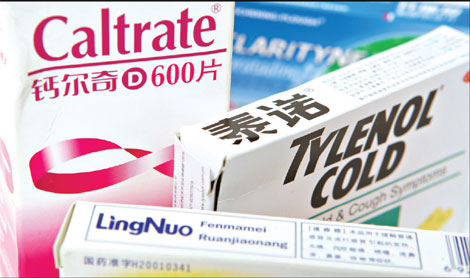Healthcare reform plans giving pharm stocks big boost
Updated: 2010-04-23 07:12
(HK Edition)
|
|||||||||
|
Tylenol Cold sold in China is surrounded by Schering-Plough's Clarityne - generic Claritin manufactured by Chinese company Venturepharm, and LingNuo, a Chinese-manufactured drug used to treat common cold and flu symptoms. A new boost to Chinese medical stocks can be expected since Beijing has promised to create a national healthcare safety net. Andrew Harrer / Bloomberg News |
Beijing's promise to create a national healthcare safety net has investors buzzing about the potential for Chinese medical stocks - ranging from drug makers and distributors to those selling medical devices.
The appetite for such stocks has grown with each new announcement bringing healthcare reform closer. China drug sales reached $34 billion in 2007, and analysts see the market growing at a steady 20 percent per year.
Limited choice in the market, especially for overseas investors, has fuelled a rally in Chinese pharmaceutical stocks, such as leading drug distributor Sinopharm, which trades at more than 50 times forecast 2010 earnings, well above the 15 times for the broader Hang Seng Index.
Pharmaceutical stocks have another attraction - relative immunity to economic cycles.
"The beauty of investing in pharmaceuticals is they are not correlated to the market," said William Lo, an analyst at Ample Finance Group, which has 6-7 percent of its portfolio invested in the sector.
"To a certain extent they carry less risk, especially for long-term funds and hedge funds," he added.
Analysts see the sector partly as a domestic consumption story as people spend more on healthcare products and services as their incomes rise, aided by improving state insurance coverage.
China's 1.3 billion medical consumers also hold great promise for foreign drug makers, especially those with patents on drugs with no ready alternatives. US giant Eli Lilly, which achieved $270 million in China sales last year, expects China to have $40 billion in annual sales by 2013.
Medical devices have potential, too, as new clinics and hospitals are set up and existing ones expand and improve their facilities under a reformed healthcare system.
"We see room for growth in the medical device segment in the long run," said Yang Dong, an analyst at Guotai Junan, who noted that "the government is set to pour in more investment to give those (older) facilities major upgrades." Yang added he expects medical device sales to grow 15-18 percent this year.
Shares in Shandong Weigao Group Medical Polymer, Asia's second-largest medical equipment supplier by market value, have surged 31 percent this year, but still trade at a relatively modest 14 times estimated earnings.
United Laboratories, up almost 85 percent in the past 30 days, trades at about 16 times forward earnings, while China Shineway and Lijun International both trade at 24 times.
"People will find those stocks a bargain when they take Sinopharm as the benchmark, which is trading at 50-60 times PE, when they are 20-30 times only," said Lo from Ample Finance.
Reuters
(HK Edition 04/23/2010 page3)
